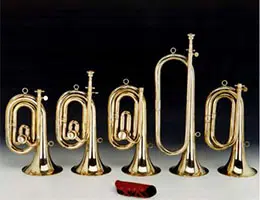 The term cornet is a diminutive of horn . The concept refers to a wind instrument that is similar to the bugle . Depending on its characteristics, the bugle is used in various areas, the most common being marches and military ceremonies.
The term cornet is a diminutive of horn . The concept refers to a wind instrument that is similar to the bugle . Depending on its characteristics, the bugle is used in various areas, the most common being marches and military ceremonies.
It is a metal musical instrument whose sound , deeper than that produced by the bugle, is obtained when the musician's lips vibrate in the mouthpiece and generate a flow of air.
The cornet has its origins in the post cornet , also called post horn , which was born with an arc shape and later became circular. This instrument was used to announce the arrival or departure of mail. At the beginning of the 19th century , pistons were added to the post cornet and thus the contemporary cornet emerged.
Thanks to the three pistons that the cornet has, the performer can alter the pitch of the sound. Cornets are used in classical music, jazz, and military bands. Louis Armstrong , Don Cherry and Herbert L. Clarke are some of the cornetists who stood out throughout history .
The bugle that does not have pistons is currently known as a natural bugle or marching band bugle . In this case, the different sounds are obtained depending on the pressure and position of the lips.
Within the range covered by the cornet, which covers approximately one and a half octaves with certain particular exceptions, the height of the sound is directly related to the expulsion of air carried out by the musician at each moment. Wind instruments are usually very tiring, and that is why it is recommended to reach a state of relaxation before starting to play.
Although it may seem like an attractive instrument to many, given its peculiarity, it is important to note that the study of the cornet is very arduous and sacrificial, since it takes a lot of time and effort to begin producing the desired melodies. As with other instruments, especially wind and string instruments, the first stage of learning is characterized by a constant struggle against the "resistance" until finally an understanding is reached that allows the production of music .
Precisely, to embark on a cornet course it is necessary to arm yourself with patience, as well as deep motivation and an enthusiasm that is renewed every day, to face obstacles. It is advisable to have a role model, a performer whose passion and skill has inspired us to learn.
 Broadly speaking, we can say that the cornet is held with one hand and played with the other; the latter is used to rotate the conveyor. It is important not to apply too much pressure on the mouthpiece, as this can negatively impact the vibration of the lips.
Broadly speaking, we can say that the cornet is held with one hand and played with the other; the latter is used to rotate the conveyor. It is important not to apply too much pressure on the mouthpiece, as this can negatively impact the vibration of the lips.
The characteristics of the sound of an instrument, be it the human voice or one created artificially, represent one of the most important aspects, since it is what the listener can appreciate the most, regardless of their technical knowledge. In this case we find an instrument that belongs to the trumpet family, and both stand out for providing a very particular shine to musical groups, especially in the military field, where they enjoy a greater role.
One of the first features of the bugle's sound is its considerable height, in addition to its stridency , something that can probably be explained taking into account the original applications of this instrument, which always revolved around starting battles or sending signals. .
It should be noted that the idea of a bugle can also be used to refer to a loudspeaker (speaker) or a whistle-blowing individual , depending on the country.
